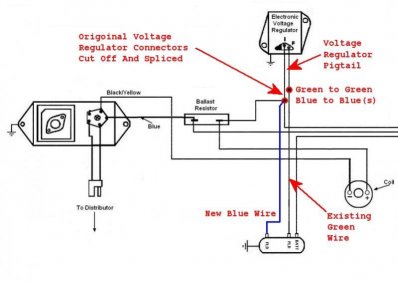mgm1986
Active Member
Alright, I am stumped. Issues with flickering lights at higher RPMs. I got a great recommendation from Big_John to upgrade my mechanical voltage regulator using VR706 (http://www.autozone.com/autozone/parts/Duralast-Voltage-Regulator/_/N-5yc1s?itemIdentifier=129965).
I also got a great link from Commando on the mopar charging system. (http://www.mymopar.com/charging.htm)
And now I am confused. Is this a 'plug and play' upgrade when using the VR706 VR? There are two wires on the blade connector, blue and blue/white and one green wire screwed in to the VR. I'd like to keep my alternator as it works fine. In the diagram below it assumes I have a new style alternator. I dropped the new VR in place and now have a constant 12.4 volts at the battery. With the mechanical VR my volts would increase up to 14.8 depending on engine RPM.
How do I upgrade to the VR706 and keep my alternator? Is it possible? :sSig_thanks:

I also got a great link from Commando on the mopar charging system. (http://www.mymopar.com/charging.htm)
And now I am confused. Is this a 'plug and play' upgrade when using the VR706 VR? There are two wires on the blade connector, blue and blue/white and one green wire screwed in to the VR. I'd like to keep my alternator as it works fine. In the diagram below it assumes I have a new style alternator. I dropped the new VR in place and now have a constant 12.4 volts at the battery. With the mechanical VR my volts would increase up to 14.8 depending on engine RPM.
How do I upgrade to the VR706 and keep my alternator? Is it possible? :sSig_thanks:



















